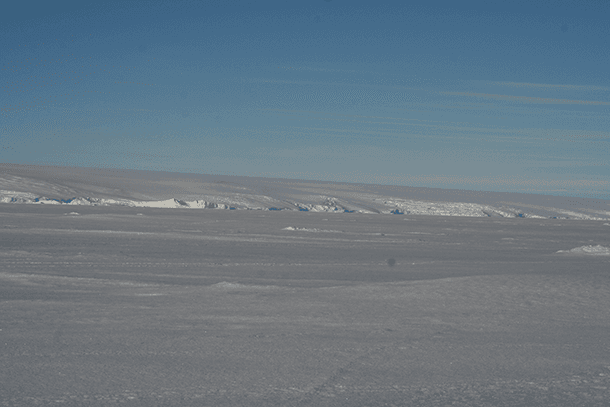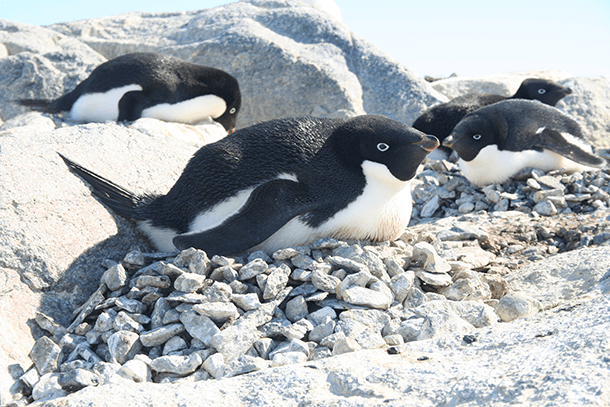In Antarctica, displaced penguins may be a sign of climate change
Adelie penguins on nests, Cape Denison, Antarctica
When researchers who study Adelie penguins in Antarctica returned to their study site to find most of the birds gone, the event made headlines. But the headlines were mostly wrong, according to the researchers.
No one knows for sure what became of the missing birds, but Kerry-Jayne Wilson, one of the lead researchers and the author of a new paper about the event, wants to make one thing clear:
“I don't know where the ‘150,000 dead penguins’ came from. It didn't come from our paper,” she says. “We did not suggest that adult penguins were being killed by this event. So some media outlet came up with ‘150,000 dead penguins’ and it's been repeated over and over again. We have recently put out a statement online correcting the misreporting of our work.”
Wilson, now retired from Lincoln University at Canterbury in New Zealand, is part of a long-established research team that studies how Adelie penguins are affected by climate change in Antarctica. In 2013-2014, the scientists returned to the colony’s summer breeding ground and found just a fraction of its former population.
It was quite a shock, Wilson says.
“Adelies are very aggressive normally, and very active penguins,” she explains. “They are usually very noisy, but now the colony was silent. They were very subdued, sitting quietly and hardly acknowledged our intrusion. Normally when you're working with Adelies, they will come at you if you get too close to the colony — hit you with their flippers, try biting you. And there were far fewer penguins than we would have expected to be there.”
The researchers did find thousands of dead penguins — but they were chicks, not adults, and many of them had probably died in the last year or two from lack of food. Wilson believes this is what happened:
In 2010, a Rhode Island-sized iceberg named B09B got stranded about 60 or 70 kilometers offshore of Cape Denison, where this Adelie colony breeds. Over the next couple of years, fast ice formed in the area between the land and the iceberg, isolating the breeding ground from open water. This cut the penguins off from their food supply and left them unable to feed their chicks.

While the researchers can’t account for the missing adult penguins, Wilson believes “it’s highly unlikely that they’ve died.”
“It's most likely that they did not bother to come back and attempt to breed,” she says. “The really clever ones assessed the situation, assessed it as a year in which they will fail [to breed], and so they didn’t try. The ones that aren't quite so clever have made the long trip to the colony and have attempted to breed and have failed, either at the egg stage or the chick stage.”
So, if the colony has not died off and the “clever ones” haven’t come back, where have they all gone?
“They'll just remain at sea,” Wilson says. “They can live at sea for years. … The only reason penguins come back to the colony is to breed. So, if it's not suitable to breed, they just remain at sea, out on the pack ice — ice floes, that are moving at the whim of the currents in the wind. Some may have gone to other colonies closer to open water, but my guess is that most just didn't bother [to come back] and cut their losses.”
Adelie penguins live all around the edges of the Antarctic continent. In the northernmost parts, on the Antarctic Peninsula below South America, Adelie penguins are in decline due to climate warming. The water temperature is rising, so there is less ice available.
On the other hand, in the southern part of Antarctica, around the Ross Sea region, Adelie numbers have been going up. In east Antarctica, the area that Wilson works, Adelie numbers tend to be stable, but researchers predict that they will decline somewhat with changing pack ice conditions, Wilson says.
The Antarctic has warmed by a degree or so over the past decade, which causes the ice on the continent to flow into the sea more quickly. So all around Antarctica there are some huge ice shelves — floating shelves of glacier ice. From time to time, icebergs break off the ends of these shelves.
“What we believe at this stage is that the break off of mega-icebergs is becoming more frequent,” Wilson says. “We believe that in the next century or so, with climate warming, [we will see] an increase in the frequency of these dire events.”
This article is based on an interview that aired on PRI's Living on Earth with Steve Curwood
